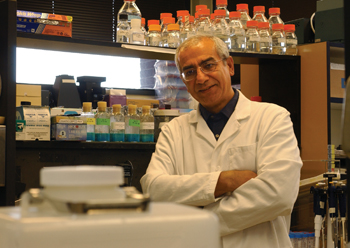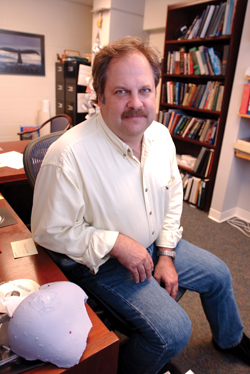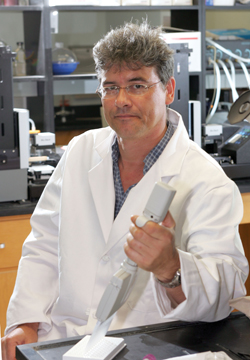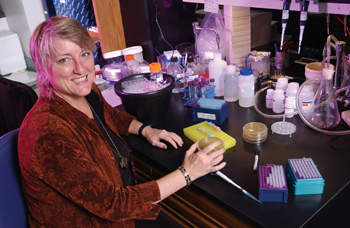
Essam Enan, Ph.D., is developing safer, more effective insecticides through his startup company, TyraTech LLC. He is among a wave of entrepreneurs who are attempting to bridge the gap between scientific discovery and commercial application.
photo by Anne Rayner
Transferring technology: Faculty form companies to nurture ideas

Robert Galloway Jr., Ph.D., Pathfinder Therapeutics Inc.
photo by Dana Johnson

Grant Yeaman, Ph.D., Valeo Medical Inc.
photo by Neil Brake

Billy Hudson, Ph.D., NephroGenix Inc.
photo by Anne Rayner

Heidi Hamm, Ph.D., CUE Biotech Inc.
photo by Anne Rayner
When ideas for technology come to Vanderbilt scientists, engineers and physicians, they can turn to the Office of Technology Transfer and Enterprise Development for patent assistance, licensing, business guidance and investor connections.
Vanderbilt devotes considerable resources to help turn intellectual property into new sources of University funding.
Thomas D. Noland's enterprise development group works with faculty whose ideas call for their own commercial start-up.
“Among universities, there is a vibrant entrepreneurial spirit that I think is unique to Vanderbilt,” Noland said.
After a new concept has won the participation of outside investors, Vanderbilt itself may join in as an investor, as is the case with all companies highlighted in this article. The Chancellor's Fund was set up for that purpose in 1998 with an original commitment of $10 million.
The following is a brief look at some of the current early stage biotech companies created by Vanderbilt University Medical Center faculty. Behind each of these companies are Vanderbilt scientists and doctors who are eager to find proper commercial backing and see their ideas benefit as many people as possible. Given commercial life, it is hoped their ideas can improve health and save lives.
TyraTech LLC
Conventional chemical insecticides usually pose some degree of harm to the environment and to humans. The technology under development by Essam E. Enan, Ph.D., research professor of Biochemistry, and his company, TyraTech, may soon lead to the commercial release of safer, more effective insecticides.
TyraTech's edge is its screening method, which is focused on certain cellular receptors belonging to the super family of G-protein coupled receptors (GPCRs). In humans, insects and other organisms, GPCRs pick up vital chemical signals from outside a cell and relay them to the inside. Disruption of receptors can repel or kill insects. TyraTech clones selected GPCRs of insects and reproduced them in different cell models, allowing rapid screening of thousands of potential insecticides.
“This allows more accurate prediction of insect response and allows manufacturers to optimize their formulation, reduce development costs and get products to market more rapidly,” Enan said.
To find safer insecticides, TyraTech is using natural substances, formulations of plant essential oils, to disrupt olfactory and biogenic amine receptors that are expressed only in non-vertebrates. The company has developed formulations for mosquitoes, head and body lice, ants, termites, dust mites and other species. The formulation for mosquitoes has been shown to be as effective as DEET, but without the potentially harmful side effects, Enan said.
XL TechGroup, the parent company of TyraTech, develops biotech and ecotech businesses to address unmet market needs. They plan to be able to sell TyraTech to an established insecticide producer within three years. Vanderbilt University is an investor in TyraTech.
Pathfinder Therapeutics Inc.
This company is creating a system for image-guided liver surgery, with metastatic disease being the main target.
It starts with a CT or MRI scan; for removal of a tumor, the system allows the surgeon to use a probe during the surgical procedure to match points on the surface of the liver with corresponding points on the radiological image of the liver. Using these surface coordinates to register the image to the organ, the system can predict precisely where the tumor is located relative to any point on the surface of the liver. This helps the surgeon avoid major blood vessels and allows a more conservative surgical approach with minimal loss of healthy tissue.
Vanderbilt engineers and surgeons pioneered image-guided brain surgery and this is the first application in soft abdominal tissue.
“We wanted to create a small company both to prove the market and to set the standard for this technology,” said Robert L. Galloway Jr., Ph.D., professor of Biomedical Engineering. Pathfinder started from a more versatile image-guided surgery system created by Galloway and his graduate students, called Orion; in adapting Orion for use with a single organ like the liver, the company is able to create greater simplicity of use for surgeons.
Galloway and faculty partners put up money to start the company. Last fall they attracted some investor participation from venture capital companies and from Vanderbilt University. Pathfinder has since begun a formal search for investors, called series A financing in venture capitol parlance.
They're looking for a CEO. “The history of inventor-run companies is extremely dismal,” Galloway said. “It will be hard to give up our baby, but we all have our day jobs.”
Other Vanderbilt participants include Alan J. Herline, M.D., Michael I. Miga, Ph.D., James D. Stefansic, Ph.D., Benoit M. Dawant, Ph.D., and (now at the University of Washington in St. Louis) William C. Chapman, M.D.
NephroGenix Inc.
Kidney failure generally results from systemic problems arising elsewhere in the body, so there are thought to be many routes to kidney failure and there is considerable variation from one patient to the next when it comes to finding an effective treatment.
These complexities have stymied development of new drugs for prevention, said NephroGenix co-founder Billy G. Hudson, Ph.D., Elliot V. Newman Professor of Medicine and Biochemistry.
Hudson said the missing link in treatment is understanding of the pathogenic pathways that set the stage for kidney failure, adding that these pathways can be sorted out by their associated genetic and proteomic markers. Hudson's company is using proteomics and genomics to understand the variations at work in kidney failure and to predict which new or existing compounds will benefit which patients.
NephroGenix has studies under way in lab animals to find out which drugs succeed with which pathways. Noting that 80 percent of all clinical trials end in failure, Hudson said Nephrogenix's understanding of bio-markers will point to the most promising compounds and help the company avoid failure at the clinical trial stage.
The business plan has three parts: buy promising pre-clinical drugs and develop them; find promising drugs that are in clinical trials for uses other than treating kidney failure and co-develop them for application in the kidney; and license for clinical application the company's findings about which existing drugs are likely to be effective given a particular set of genetic and proteomic markers.
Series A funding is nearing completion and Vanderbilt University is among the investors. Hudson said it's likely that NephroGenix will eventually partner with one of the large drug companies collectively known as big pharma.
Hudson founded the company with Karl Tryggvason, M.D., Ph.D., of the Karolinska Institute in Stokholm. The principal Vanderbilt participants in addition to Hudson include Eric G. Neilson, M.D., Richard M. Caprioli, Ph.D., and Daniel C. Liebler, Ph.D.
Valeo Medical Inc.
This company is developing the first blood test for the diagnosis of endometriosis.
In this disease, the mucous membrane lining the uterus, called the endometrium, takes wayward presence in other areas of the pelvis, causing cysts, scar tissue and adhesions. The pain of endometriosis may become extreme. The disease is present to one degree or another in 5 percent to 15 percent of women of reproductive age, and it's a leading cause of infertility, said Grant R. Yeaman, Ph.D., assistant professor of Obstetrics and Gynecology.
There are successful surgical interventions for endometriosis, but diagnosis requires a laparoscopic surgical procedure and the average time from the onset of symptoms to diagnosis is seven years.
It isn't known what causes endometriosis, but in some ways it resembles auto-immune disease. In research he conducted at Dartmouth, Yeaman matched the antibodies present in endometriosis to a common antigen, and began work on diagnostic methods based on measuring antibodies in clinical blood samples.
Yeaman filed patents while at Dartmouth and he has filed more since coming to Vanderbilt and further refining his ideas. Valeo has completed a second round of venture capital funding and Vanderbilt University is among the investors. A large clinical trial is scheduled to conclude in the fall.
Yeaman expects the company to be sold before the commercial stage. Meanwhile, he continues with research that may lead to drug therapies for treatment of endometriosis. The other Vanderbilt participant in Valeo is Kevin G. Osteen, Ph.D.
CUE Biotech Inc.
G-protein coupled receptors (GPCR) accept a range of vital chemical signals from outside a cell and relay them to G-proteins inside a cell. Heart disease, metal illness and cancer are among the disease categories tied in various ways to the malfunction of GPCRs and their corresponding intracellular G-proteins; and a whopping half of all drugs are designed to block one bodily substance or another from docking with GPCRs.
While traditional pharmacology seeks to block substances outside the cell from docking with receptors, CUE Biotech Inc. is focused instead on interrupting action on the inside of these receptors, where G-proteins are wont to pick up signals relayed from outside.
In a lab at the University of Illinois at Chicago, Heidi E. Hamm, Ph.D., worked out how to slip the right small molecule inside a cell to mimic a particular G-protein and block its interaction with a receptor.
“It's a novel way to create inhibitors,” said Hamm, who today is the Earl W. Sutherland Jr. Professor and chair of Pharmacology and professor of Ophthalmology.
Each type of GPCR (there are 300 kinds) interacts with multiple kinds of G-protein. Hamm's method is different precisely because it doesn't block the receptor altogether and thus indiscriminately halt all signaling. It's a more refined approach that could lead eventually to the development of drugs having fewer side effects.
The company has a two-part business model: (1) develop small-molecule inhibitors, prove them in animals, and market them to drug companies, or (2) take a less capital-intensive approach of entering a series of agreements to serve drug companies in their efforts to disrupt specific signaling pathways.
Preventing G-proteins from binding with their receptors is a wholly new therapeutic approach, so CUE Biotech is naturally more of a wild card for investors. Since the company was formed in 2000, the investment market for early stage biotech has worsened considerably, Hamm said. CUE Biotech at first subsisted on small-business grants from the NIH and more recently has formed a service contract with a drug company to screen a particular GPCR. There are more such contracts on the horizon. Vanderbilt University is an investor.













